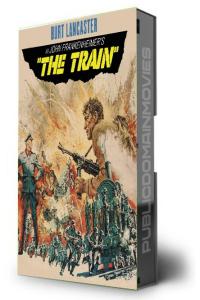
The Train (1964): A Gritty, Masterful War Thriller That Still Dazzles
John Frankenheimer’s The Train (1964) isn’t just a war film. It’s a ferocious, steam-powered meditation on the price of culture, the cost of resistance, and the cold machinery of war—both literal and human. Anchored by a towering performance from Burt Lancaster and directed with gritty precision, The Train remains one of the most riveting World War II dramas of the 1960s.
The Train is a copyrighted MGM/United Artists production, preserved and distributed through official channels. This is a fanedit colorized version from Archive.org
A Story of Art, War, and Resistance
Set in Nazi-occupied France during the final days of World War II, The Train tells the story of a German colonel (Paul Scofield) obsessed with looted French art, and a French Resistance fighter (Lancaster) determined to stop a train carrying these stolen treasures to Germany. But this isn’t a heist movie or an Indiana Jones-style romp—this is blood, sweat, and steam engines. The stakes are ideological. Is a painting worth a man’s life? What, if anything, is worth saving when everything is burning?
The script, co-written by Franklin Coen and Frank Davis, asks those questions without flinching.
Burt Lancaster: Muscle Meets Morality
Burt Lancaster plays Paul Labiche, a railway man reluctantly drawn into an act of rebellion. This isn’t a role for grand speeches. Lancaster’s performance is one of grit and movement. He runs, climbs, and fights with the force of a man fueled by purpose, rage, and exhaustion. It’s a brilliant example of physical acting—tense, grounded, never showy.
Paul Scofield, as the cultured yet cold-hearted German colonel, brings chilling complexity to the antagonist. His passion for art makes him almost sympathetic—until we remember the human cost of his obsession. His villainy is one of intellect, not brute force.
Frankenheimer’s Signature Style
John Frankenheimer took over the directing reins from Arthur Penn early in production, and his fingerprints are all over The Train. Known for political thrillers like The Manchurian Candidate, Frankenheimer brings documentary-like realism and relentless pacing. The film uses real trains, real explosions, and real danger—all captured in glorious black and white by cinematographer Jean Tournier. There's no green screen, no digital magic. When things blow up, they really blow up.
Frankenheimer’s direction is pure steel—taut, efficient, and unflinchingly raw. His command of space and action makes every sequence feel urgent and alive.
A Masterclass in Practical Effects
One of The Train's most remarkable qualities is its dedication to realism. The production famously used actual locomotives and railroad tracks. The train crashes and derailments? They happened for real. And you feel every shudder and screech. There is no better reminder of how powerful practical effects can be.
The Moral Engine
Beyond the action, The Train is a movie about moral dilemmas. Is culture more valuable than human life? Should resistance come at any cost? These questions are as relevant now as they were in 1964. It’s not just about what’s on the train—it’s about who we are when faced with injustice.
Conclusion: A Forgotten Gem Worth Discovering
The Train is a high-octane war thriller powered by moral conflict, executed with the kind of muscular filmmaking we rarely see today. Burt Lancaster’s performance is unforgettable, and John Frankenheimer’s direction is a masterclass in tension and restraint. If you're looking for where to watch The Train (1964) online free, be aware that while it’s not in the public domain, it’s widely available through streaming platforms and DVD.
For fans of classic cinema, wartime thrillers, and unforgettable performances, The Train is a ride well worth taking. Just hold on tight.







